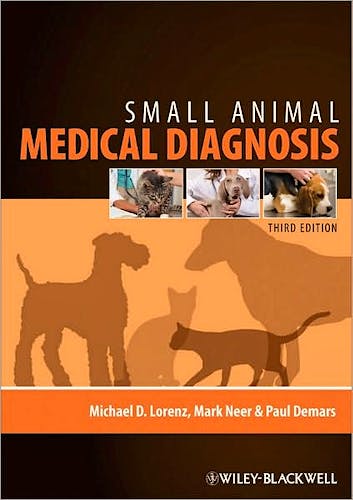

No hay productos en el carrito



Small Animal Medical Diagnosis
Lorenz, M. — Neer, M. — Demars, P.
3ª Edición Noviembre 2009
Inglés
Tapa blanda
504 pags
1400 gr
null x null x null cm
ISBN 9780813813387
Editorial WILEY
LIBRO IMPRESO
-5%
112,27 €106,66 €IVA incluido
107,95 €102,56 €IVA no incluido
Recíbelo en un plazo de
2 - 3 semanas
LIBRO ELECTRÓNICO
-5%
94,63 €89,90 €IVA incluido
90,99 €86,44 €IVA no incluido
Acceso On Line
Inmediato
Description
Small Animal Medical Diagnosis, Third Edition takes a problem-oriented approach
to clinical diagnosis, and outlines core information necessary to effectively
evaluate the major medical problems in dogs and cats. The text starts by defining
problems caused by disease and proceeds to integrate the history, physical examination,
and diagnostic modalities into a logical approach designed to assist with the
medical management of patients. The new edition continues to serve as a vital
tool in accurate and appropriate diagnosis for small animal veterinarians, emergency
and critical care veterinarians, and veterinary students.
Table of Contents
1. The Problem-Oriented Approach
Part One: General (Polysystemic) Problems
2. Pyrexia (Fever)
3. Disturbances of Food Intake: Anorexia And Polyphagia
4. Episodic Weakness
5. Polyuria and Polydipsia
Part Two: Behavioral Problems
6. Aggression
7. Fear, Anxiety, and Compulsive Behavior
Part Three: Conformational Problems
8. Ascites, Peripheral Edema, and Abdominal Distention
9. Retarded Growth
10. Changes in Body Weight: Weight Loss and Obesity
Part Four: Dermatologic Problems
11. Pruritus
12. Primary and Secondary Skin Lesions
13. Alopecia
14. Disorders of Pigmentation
Part Five: Hematolymphatic Problems
15. Bleeding Disorders
16. Lymphadenopathy
Part Six: Cardiovascular Problems
17. Disturbances of Heart Rate, Rhythm, and Pulse
18. Murmurs and Abnormal Heart Sounds
19. Abnormal Mucous Membranes
Part Seven: Respiratory Problems
20. Coughing and Hemoptysis
21. Respiratory Distress and Cyanosis
22. Syncope
23. Abnormal Lung Sounds
24. Sneezing and Nasal Discharge
Part Eight: Digestive Problems
25. Ptyalism
26. Dysphagia
27. Regurgitation and Vomiting
28. Diarrhea
29. Constipation and Flatulence
30. Abdominal Pain
31. Icterus
Part Nine: Urologic Problems
32. Abnormal Micturition: Dysuria, Pollakiuria, and Stranguria
33. Discolored Urine
34. Urinary Incontinence
Part Ten: Reproductive Problems
35. Vaginal and Preputial Discharge
36. Abnormalities of the External Genitalia
37. Abortion, Abnormal Estrous Cycle, and Infertility
Part Eleven: Musculoskeletal Problems
38. Lameness
39. Bone, Joint, and Periskeletal Swelling
40. Nociception ("Pain")
Part Twelve: Neurologic Problems
41. Paresis or Paralysis
42. Ataxia
43. Head Tilt
44. Collapse (Seizures, Syncope, Cataplexy, and Narcolepsy)
45. Stupor and Coma
Part Thirteen: Special Sensation Problems
46. Blindness
47. Anisocoria
48. Nystagmus and Strabismus
49. Loss of Corneal Transparency
50. Abnormal Anterior Chamber
51. Abnormal Lens
52. Anosmia—Loss of Olfaction
53. Deafness
Part Fourteen: Laboratory-Defined Problems
54. Hematologic Problems
55. Abnormalities of the Standard Biochemical Profile
56. Problems Identified on Urinalysis
57. Abnormal Blood pH, Anion Gap, and Blood Gases
Author Information
Michael D. Lorenz is Dean of Veterinary Medicine at Oklahoma
State University.
T. Mark Neer is Professor of Internal Medicine and Director
of the Veterinary Teaching Hospital at Oklahoma State University.
Paul DeMars is Adjunct Assistant Professor of Small Animal
Community Practice at Oklahoma State University.
© 2025 Axón Librería S.L.
2.149.0